Lubrication Analysis of Micro-Dimple Textured Die Surface by Direct Observation of Contact Interface in Sheet Metal Forming
Abstract
:1. Introduction
2. Experimental
2.1. Development of In-Situ Observation System
2.2. Fabrication of Surface Texturing
2.3. Experimental Conditions
3. Finite Element (FE) Simulation of Contact State
4. FE Based Computational Fluid Dynamics (CFD) Analysis
4.1. Laminar Two-Phase Flow Analysis
4.2. Fluid-Flow Analysis
5. Results
5.1. Contact State Analysis
5.2. In-Situ Observation of Lubricant Flow
5.3. Effect of Micro-Dimple Diameters
5.4. Effect of Lubricant Viscosity
6. Discussion
7. Conclusions
Author Contributions
Funding
Acknowledgments
Conflicts of Interest
Nomenclature
| List of symbols | ||
| b | Pitch | [mm] |
| c | Clearance between punch and die | [mm] |
| d | Dimple diameter | [mm] |
| dp | Punch with | [mm] |
| E | Elastic modulus | [GPa] |
| hd | Dimple depth | [mm] |
| hl | Lubricant film thickness | [μm] |
| hs | Maximum stroke | [mm] |
| lc | Contact length | [mm] |
| np | Number of forming processes | (dimensionless) |
| pc | Contact pressure | [MPa] |
| rd | Bending die radius | [mm] |
| rp | Punch radius | [mm] |
| t | Work sheet thickness | [mm] |
| T | Temperature | [˚C] |
| u | Kinematic viscosity | [mm2/s] |
| vp | Punch velocity | [mm/s] |
| vw | Sliding wall velocity | [mm/s] |
| vf | Flow velocity | [mm/s] |
| Vd | Volume of dimple cell | [mm3] |
| Vl | Volume of lubricant at pitch area | [mm3] |
| w | Width of die gap | [mm] |
| Greek letters | ||
| µ | Friction coefficient | (dimensionless) |
| η | Kinematic viscosity of lubricant | [mm2/s] |
| ηlub | Lubricant viscosity | [Pa·s] |
| ηgas | Gas viscosity | [Pa·s] |
| λ | Dimple aspect ratio | (dimensionless) |
| ρ | Mass density of fluid | [kg/m3] |
| ρgas | Gas density | [kg/m3] |
| ρliquid | Liquid density | [kg/m3] |
| ρd | Texture density ratio | (dimensionless) |
| σ | Surface tension coefficient | [mN/m] |
| σy | Yield stress | [MPa] |
| ν | Poisson’s ratio | (dimensionless) |
| θ | Contact angle | [degree] |
| φ | Level set function | (dimensionless) |
References
- Wagner, K.; Volkl, R.; Engel, U. Tool life enhancement in cold forging by locally optimized surfaces. J. Mater. Process. Technol. 2008, 201, 2–8. [Google Scholar] [CrossRef]
- Steinhof, K.; Rasp, W.; Pawelski, O. Development of deterministic-stochastic surface structures to improve the tribological conditions of sheet forming processes. J. Mater. Process. Technol. 1996, 60, 355–361. [Google Scholar] [CrossRef]
- Zhou, R.; Cao, J.; Wang, Q.J.; Meng, F.; Zimowski, K.; Xia, Z.C. Effect of EDT surface texturing on tribological behavior of aluminum sheet. J. Mater. Process. Technol. 2011, 211, 1643–1649. [Google Scholar] [CrossRef]
- Evans, C.J.; Bryan, J.B. “Structured”, “Textured”, or “Engineered” Surfaces. CIRP Ann. 1999, 48, 541–556. [Google Scholar] [CrossRef]
- Geiger, M.; Popp, U.; Engel, U. Excimer laser micro texturing of cold forging tool surfaces-influence on tool life. CIRP Ann. 2002, 51, 231–234. [Google Scholar] [CrossRef]
- Costa, H.L.; Hutchings, I.M. Effects of die surface patterning on lubrication in strip drawing. J. Mater. Process. Technol. 2009, 209, 1175–1180. [Google Scholar] [CrossRef]
- Xu, D.; Wu, W.; Malhotra, R.; Chen, J.; Lu, B.; Cao, J. Mechanism investigation for the influence of tool rotation and laser surface texturing (LST) on formability in single point incremental forming. Int. J. Mach. Tools Manuf. 2013, 73, 37–46. [Google Scholar] [CrossRef]
- Hamilton, D.B.; Walowit, J.A.; Allen, C.M. A theory of lubrication by micro- irregularities. J. Fluids Eng. 1966, 88, 177–185. [Google Scholar]
- Wakuda, M.; Yamauchi, Y.; Kanzaki, S.; Yasuda, Y. Effect of surface texturing on friction reduction between ceramic and steel materials under lubricated sliding contact. Wear 2003, 254, 356–363. [Google Scholar] [CrossRef]
- Varenberg, M.; Halperin, G.; Etsion, I. Different aspects of the role of wear debris in fretting wear. Wear 2002, 252, 902–910. [Google Scholar] [CrossRef]
- Ibatan, T.; Uddin, M.S.; Chowdhury, M.A.K. Recent development on surface texturing in enhancing tribological performance of bearing sliders. Surf. Coat. Technol. 2015, 272, 102–120. [Google Scholar] [CrossRef]
- Gropper, D.; Wang, L.; Harvey, T.J. Hydrodynamic lubrication of textured surfaces: A review of modeling techniques and key findings. Tribol. Int. 2016, 94, 509–529. [Google Scholar] [CrossRef] [Green Version]
- Ramesh, A.; Akram, W.; Mishra, S.P.; Cannon, A.H.; Polycarpou, A.A.; King, W.P. Friction characteristic of microtextured surface under mixed and hydrodynamic lubrication. Tribol. Int. 2013, 57, 170–176. [Google Scholar] [CrossRef]
- Profito, F.J.; Vlădescu, S.J.; Reddyhoff, T.; Dini, D. Transient experimental and modelling studies of laser-textured micro-grooved surface with a focus on piston-ring cylinder liner contacts. Tribol. Int. 2017, 113, 125–136. [Google Scholar] [CrossRef]
- Ike, H.; Makinouchi, A. Effect of lateral tension and compression on plane strain flattening processes of surface asperities lying over a plastically deformable bulk. Wear 1990, 140, 7–38. [Google Scholar] [CrossRef]
- Schey, J.A. Tribology in Metalworking. Friction, Lubrication and Wear; ASM, Metals Park: Novelty, OH, USA, 1983. [Google Scholar]
- Azushima, A.; Uda, M.; Kudo, H. An interpretation of the speed dependence of the coefficient of friction under the micro PHL condition in sheet drawing. CIRP Ann. 1991, 40–41, 227–230. [Google Scholar] [CrossRef]
- Mizuno, T.; Okamoto, M. Effects of lubricant viscosity at pressure and sliding velocity on lubricating conditions in the compression- friction test on sheet metals. Trans. ASME J. Lubr. Technol. 1982, 104, 53–59. [Google Scholar] [CrossRef]
- Bay, N.; Azushima, A.; Groche, P.; Ishibashi, I.; Merklein, M.; Morishita, M.; Nakamura, T.; Schmid, S.; Yoshida, M. Environmentally benign tribo-systems for metal forming. CIRP Ann. 2010, 59, 760–780. [Google Scholar] [CrossRef] [Green Version]
- Gachot, C.; Rosenkarnz, A.; Hsu, S.M.; Costa, H.L. A critical assessment of surface texturing for friction and wear improvement. Wear 2017, 372–373, 21–41. [Google Scholar] [CrossRef]
- Shin-etsu Quartz, Co. Available online: https://www.sqp.co.jp/catalog/images/Technology_Guide1_j.pdf (accessed on 18 November 2017).
- Tokyo Kohshin, Co. Available online: http://tokyokohshin.co.jp/wp/wp-content/themes/theme064/images/pdf/skd11_hi.pdf (accessed on 18 November 2017).
- Sethian, J.A.; Smereka, P. Level set methods for fluid interface. Ann. Rev. Fluid Mech. 2003, 35, 341–372. [Google Scholar] [CrossRef]
- Sussman, M.; Smereka, P.; Osher, S. A level set approach for computing solutions to incompressible two-phase flow. J. Comput. Phys. 1994, 114, 146–159. [Google Scholar] [CrossRef]
- Wahl, R.; Schneider, J.; Gumbsch, P. In situ observation of cavitation in crossed microchannels. Tribol. Int. 2012, 55, 81–86. [Google Scholar] [CrossRef]
- Qiu, Y.; Khonasari, M.M. Experimental investigation of tribological performance of laser textured stainless steel rings. Tribol. Int. 2011, 44, 635–644. [Google Scholar] [CrossRef]
- Azushima, A. In lubro 3D measurement of oil film thickness at the interface between tool and workpiece in sheet drawing using a fluorescence microscope. Tribol. Int. 2005, 38, 105–112. [Google Scholar] [CrossRef]
- Olver, A.V.; Fowell, M.T.; Spikes, H.A.; Pegg, I.G. ‘Inlet suction’, a load support mechanism in non-convergent, pocketed, hydrodynamic bearings. Proc. Inst. Mech. Eng. Part J J. Eng. Tribol. 2006, 220, 105–108. [Google Scholar] [CrossRef]
- Karker, A.; Ostayen, R.A.J.; Beek, A.; Rixen, D.J. A multiscale method modeling surface texture effects. J. Tribol. 2007, 129, 221–230. [Google Scholar] [CrossRef]

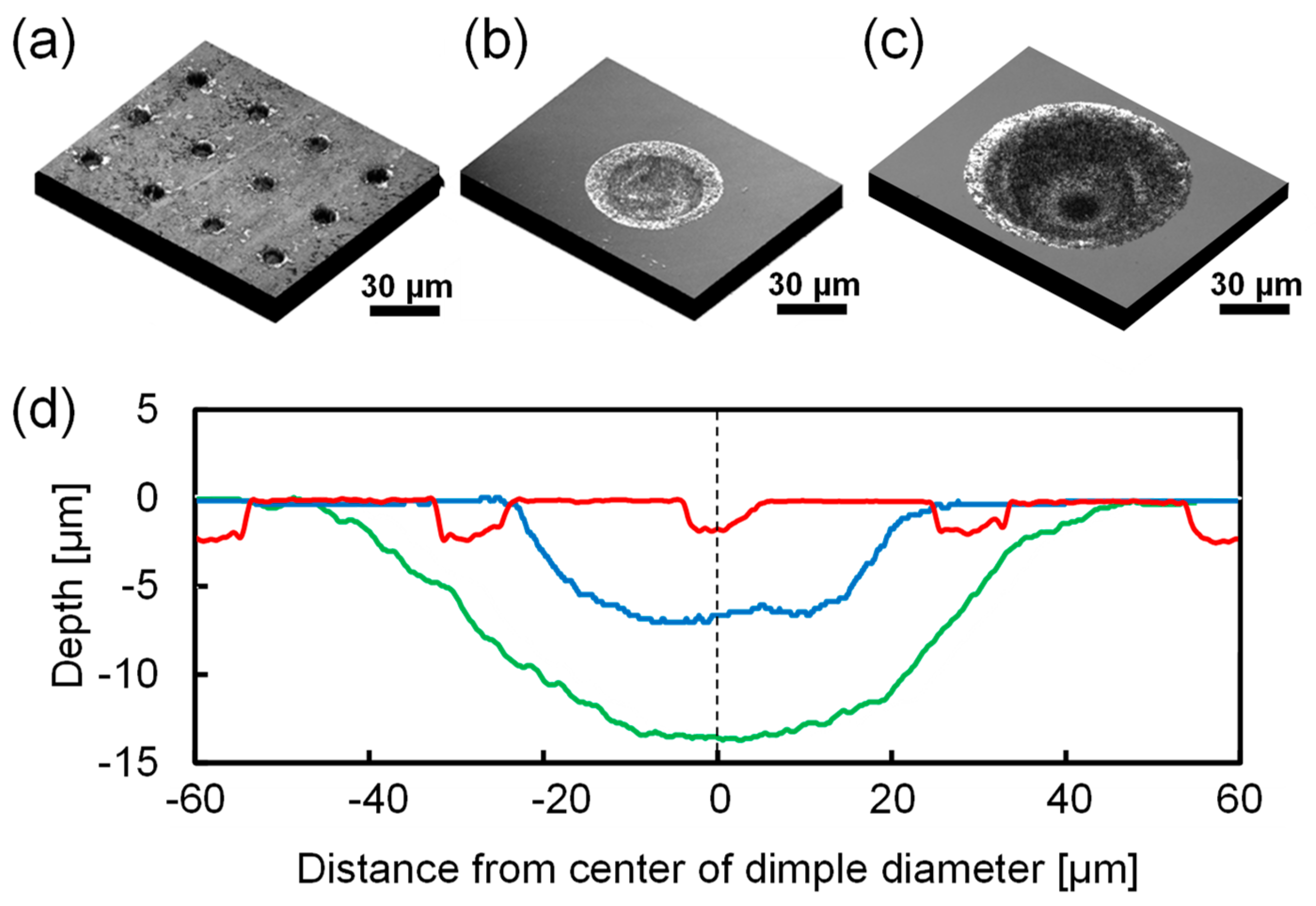
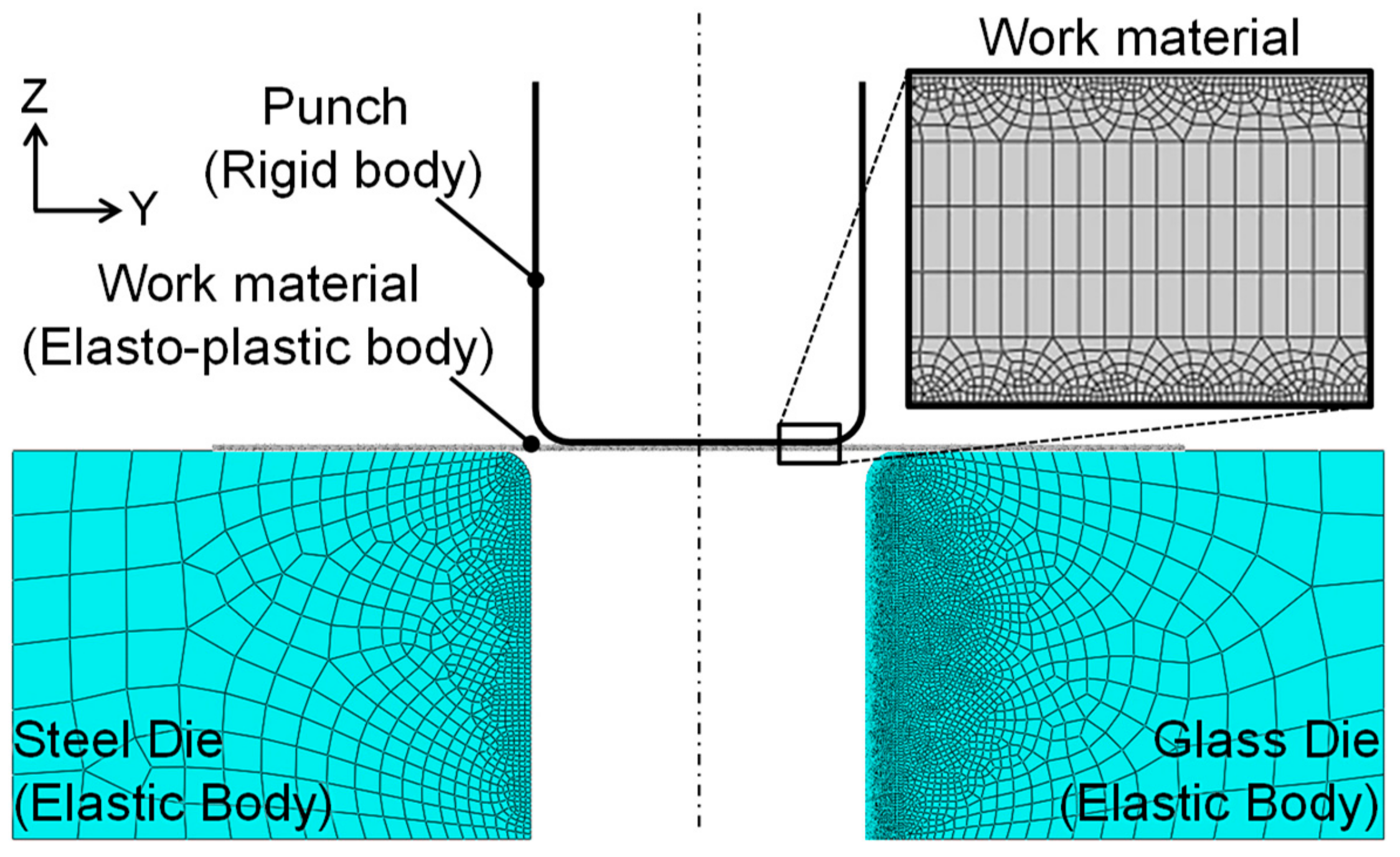
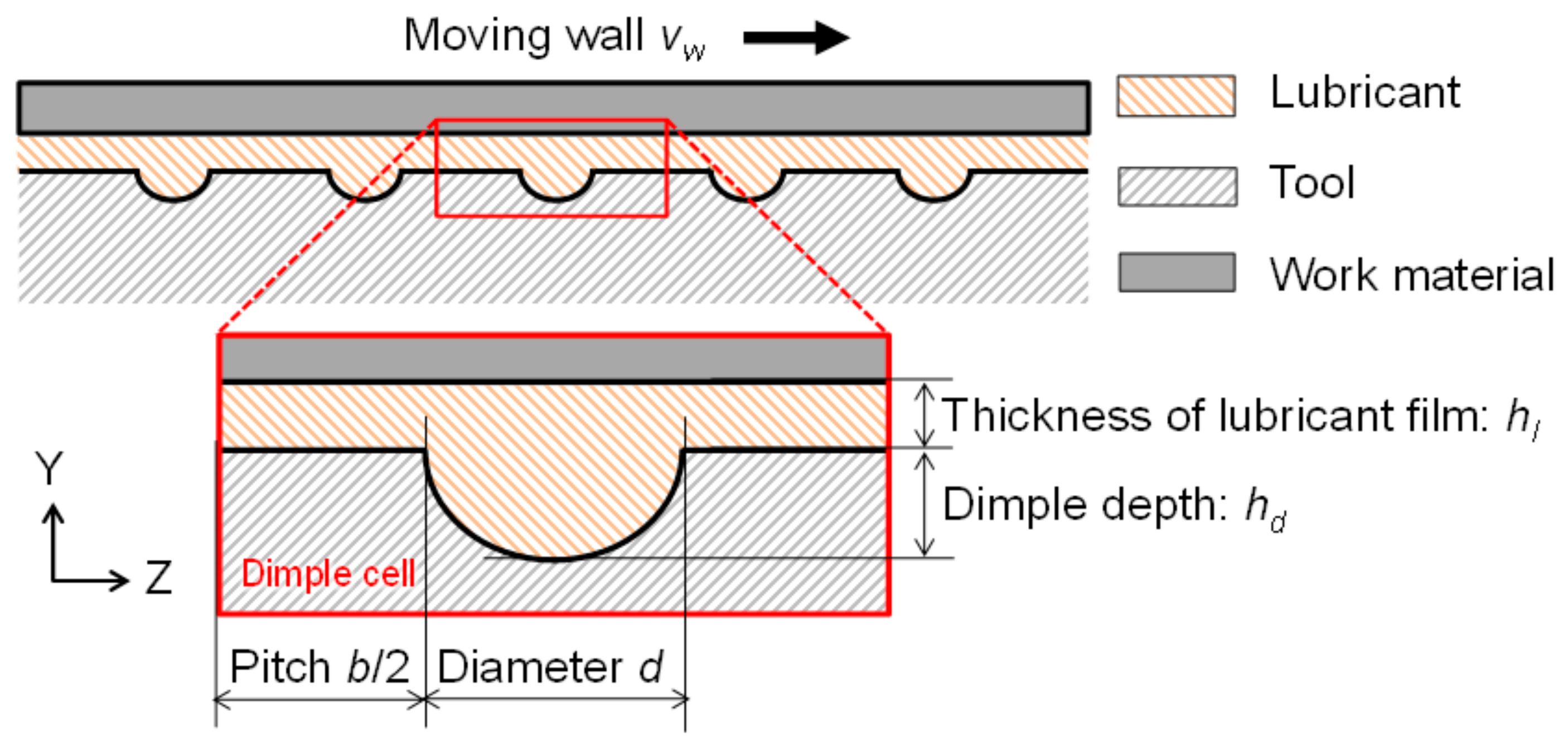
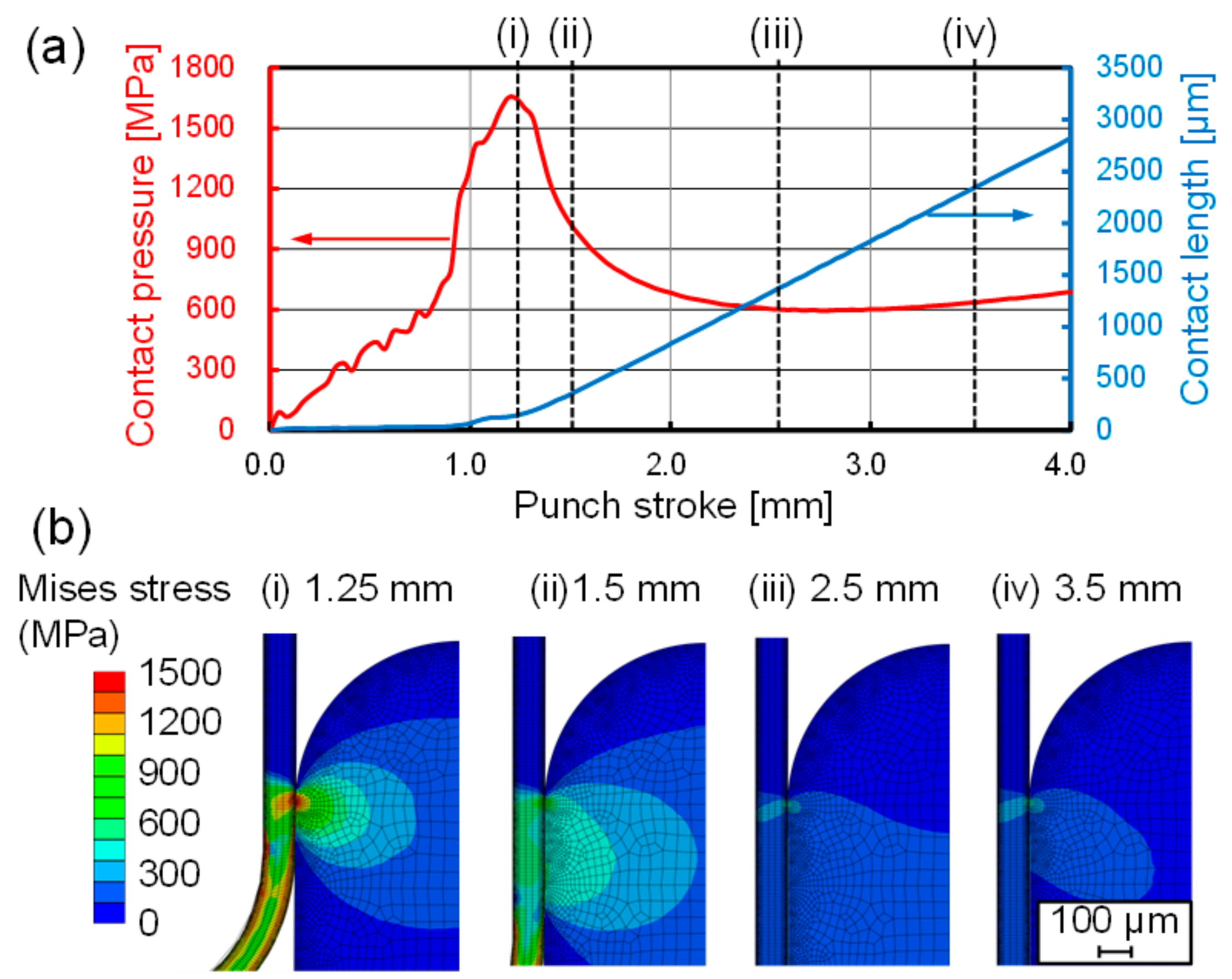
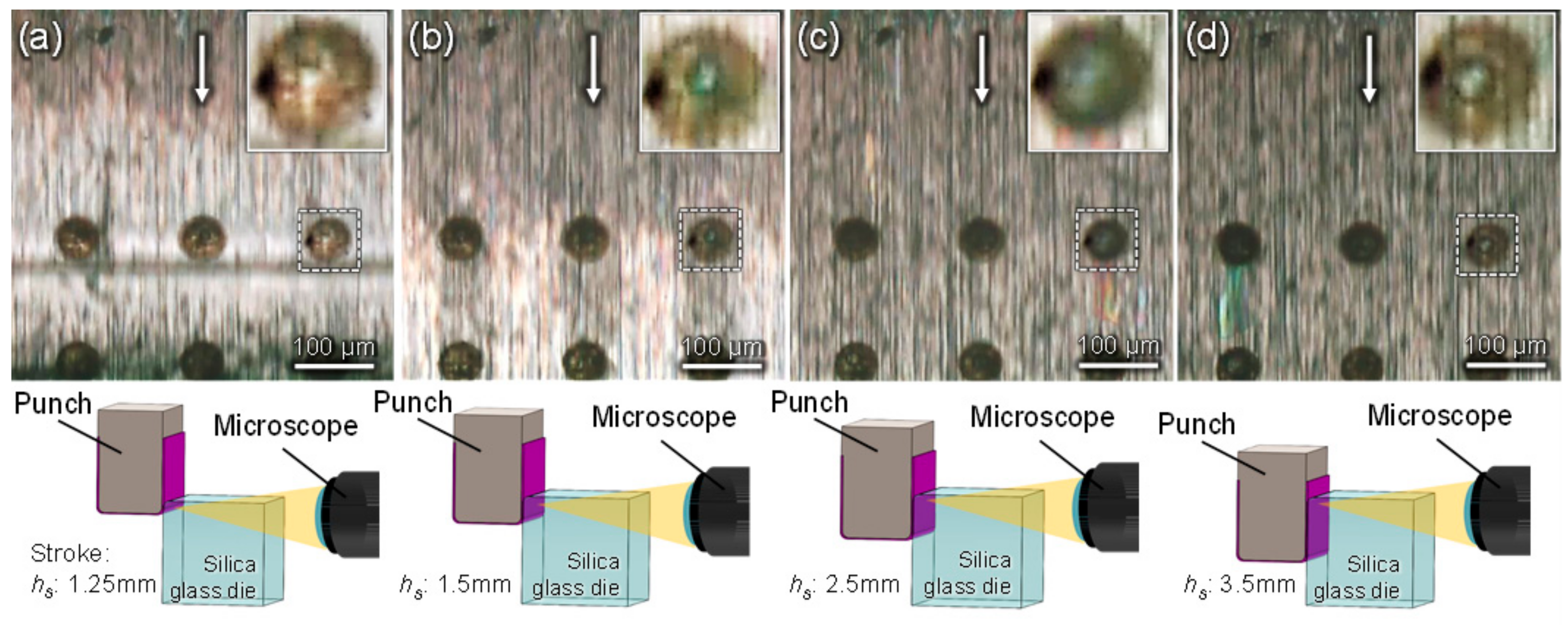
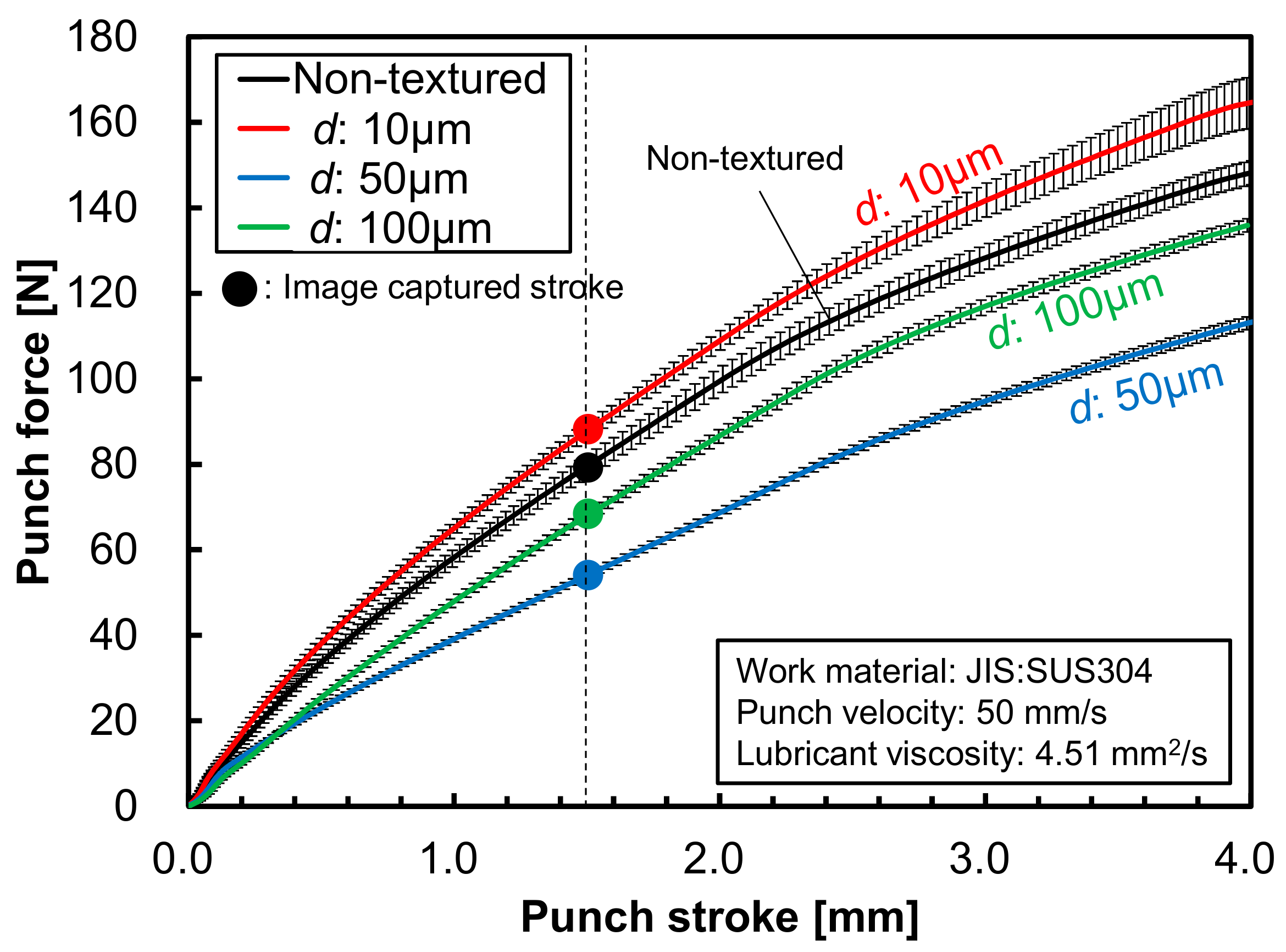
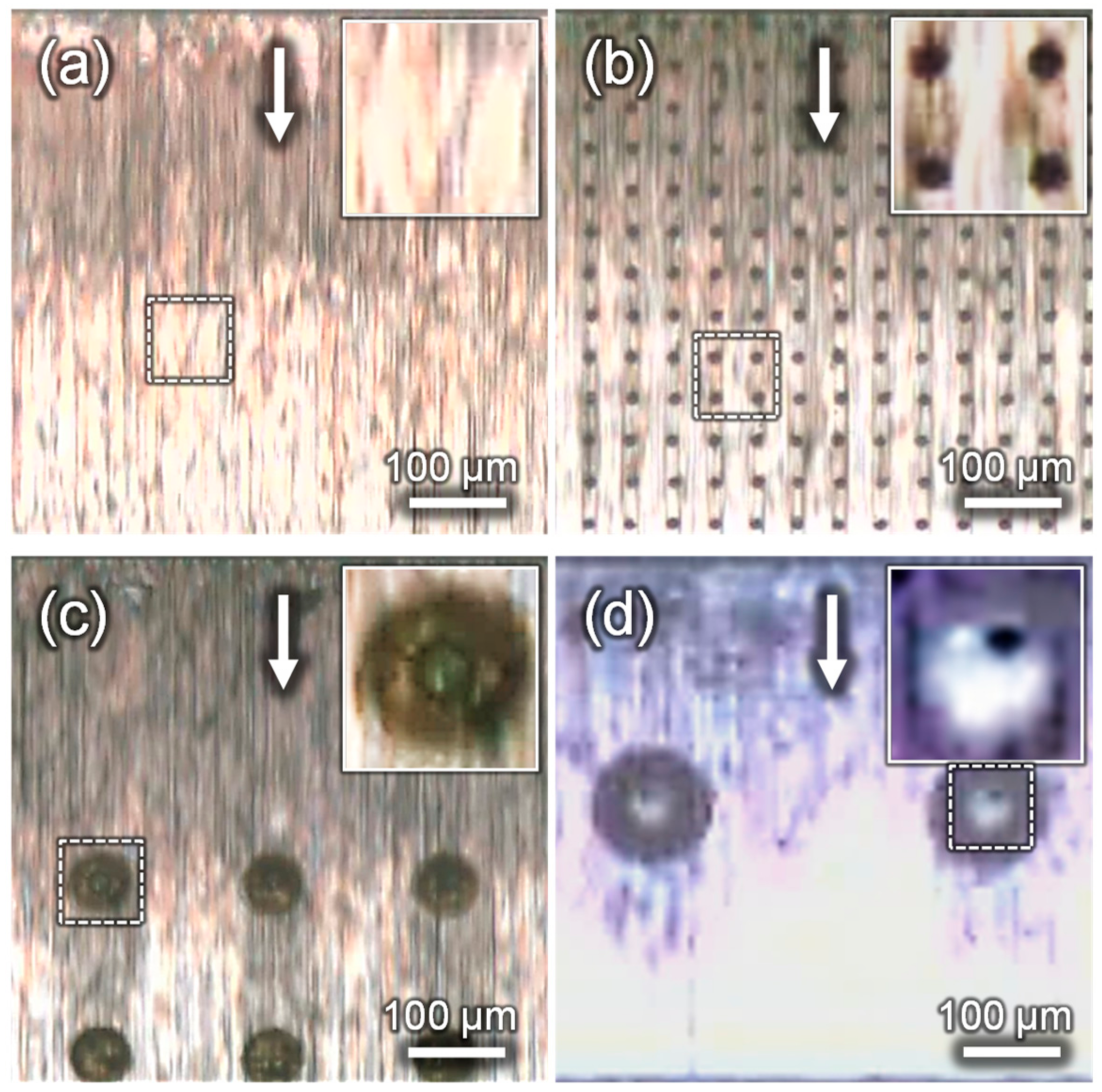
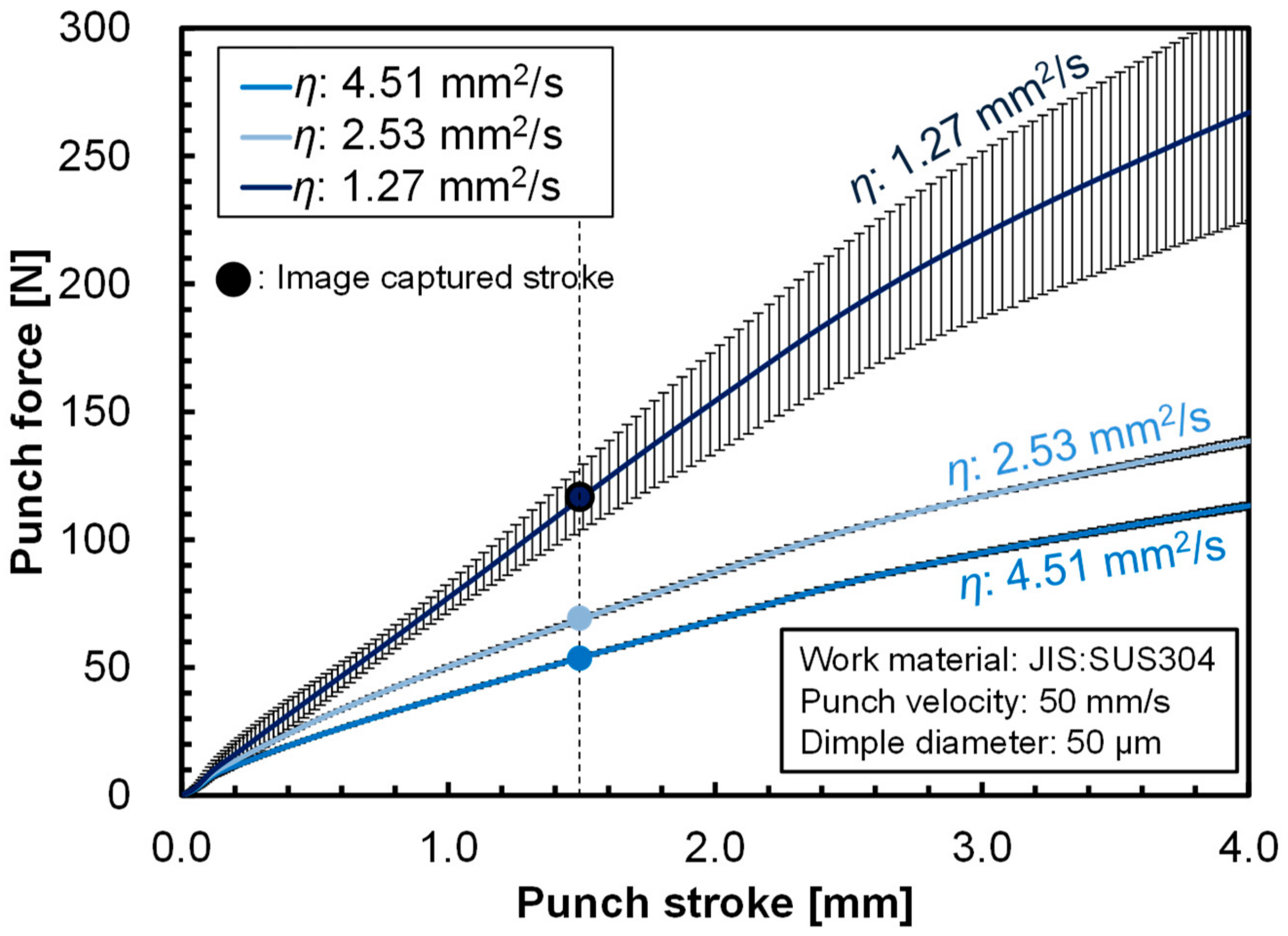

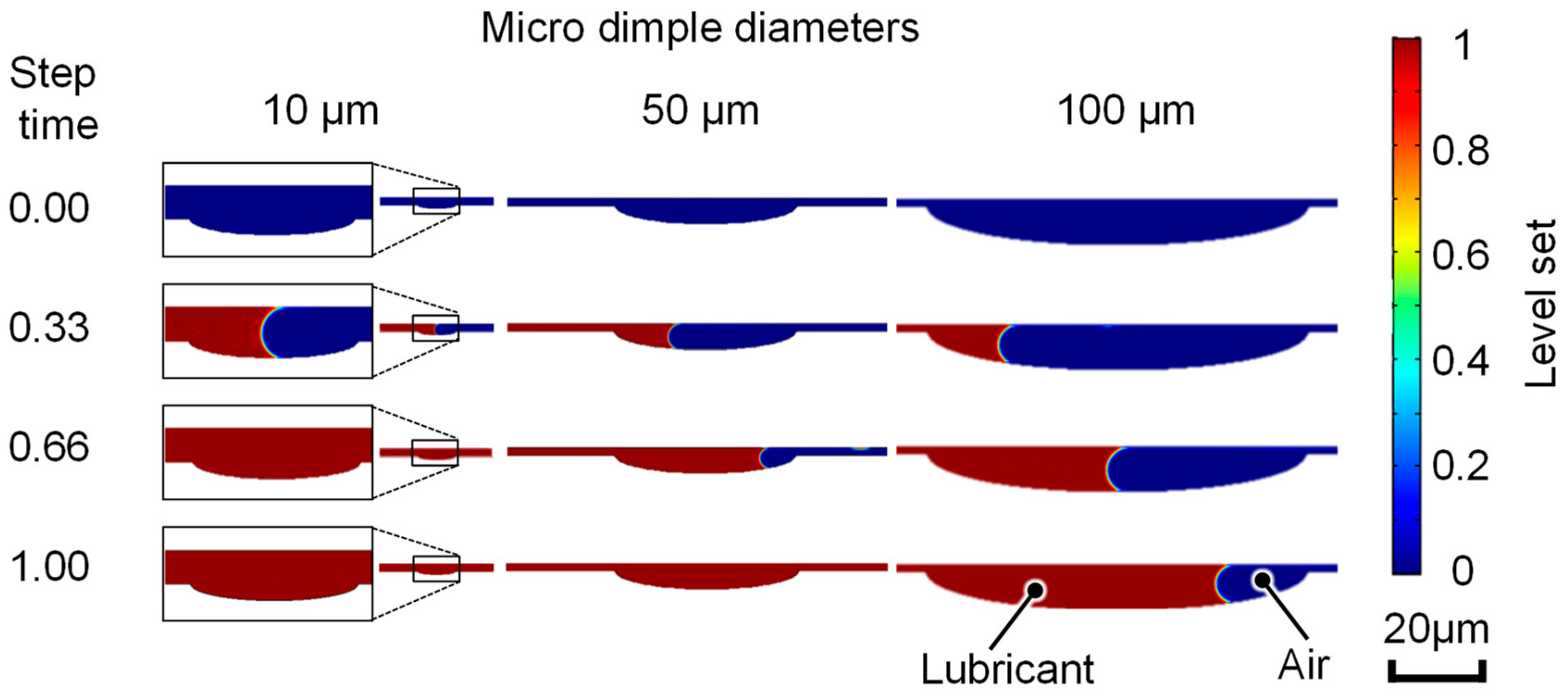
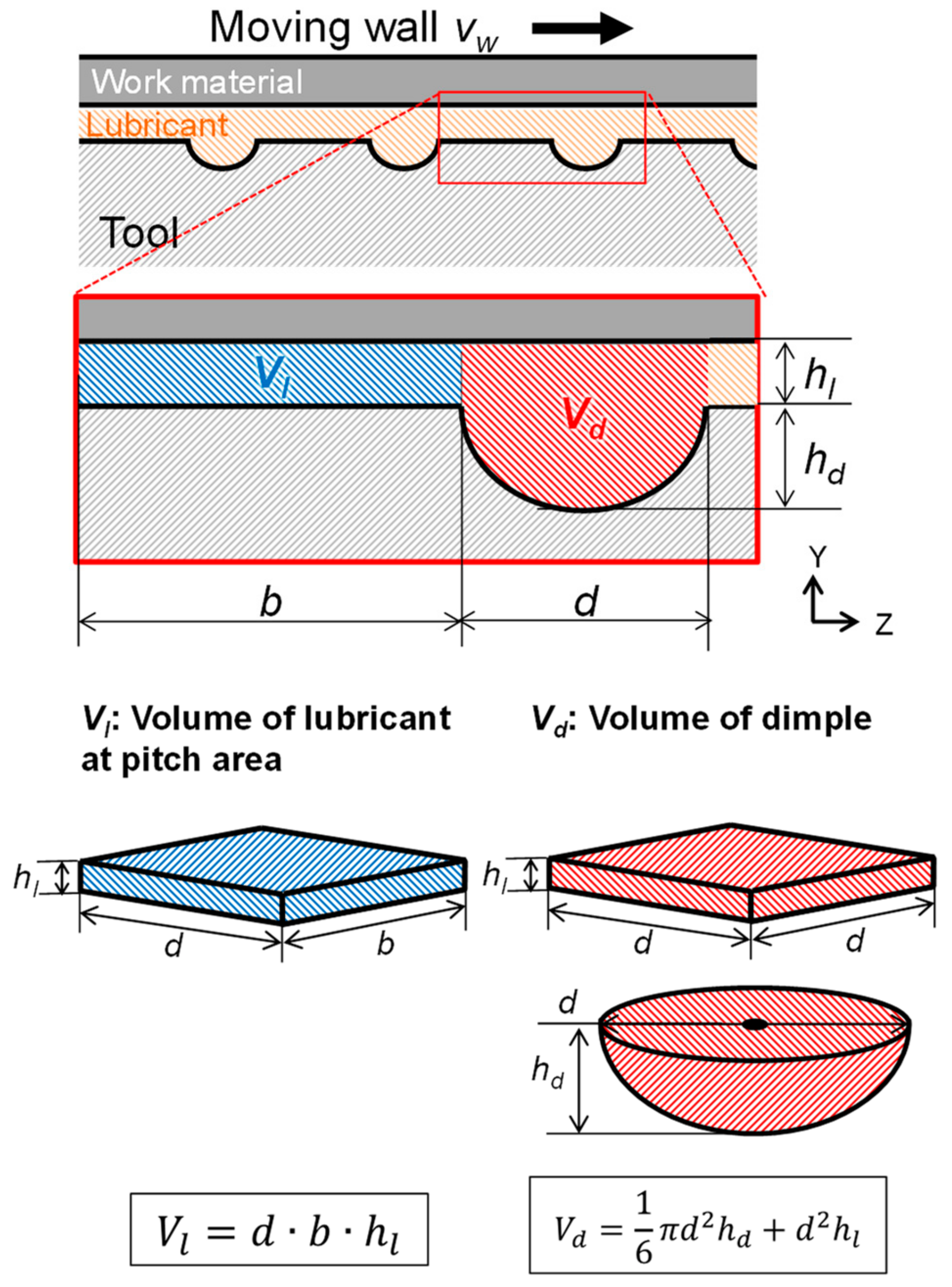
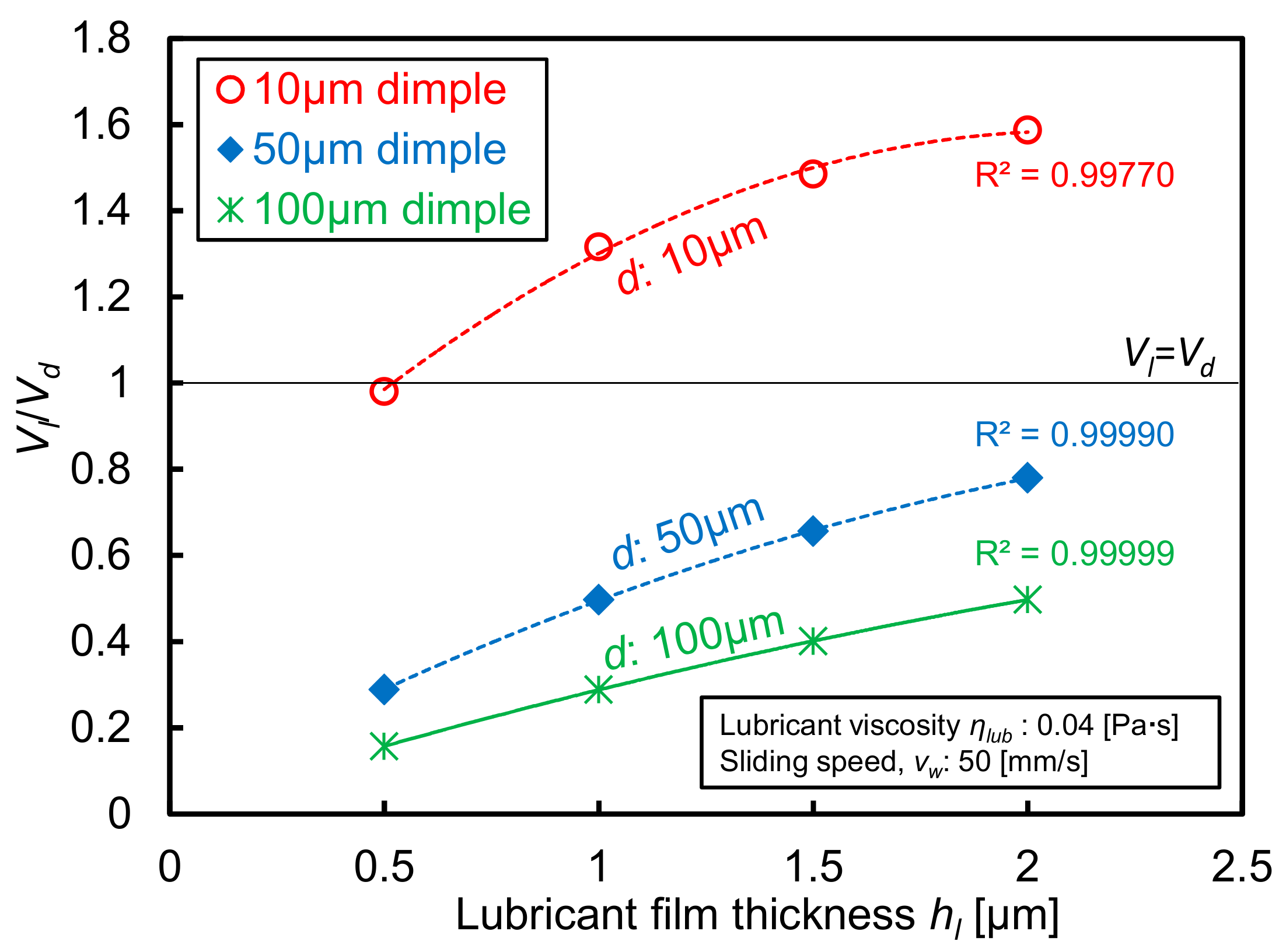
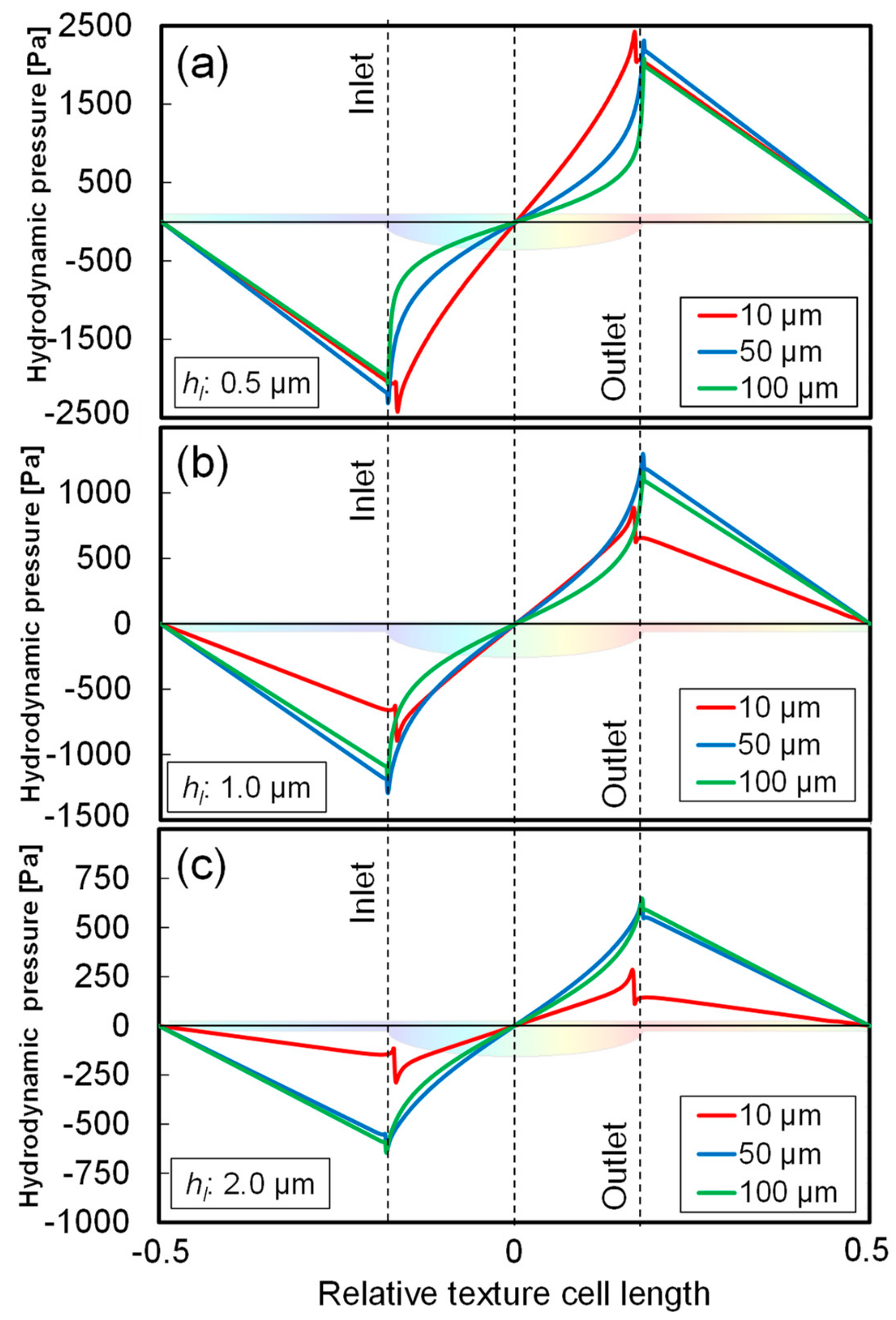
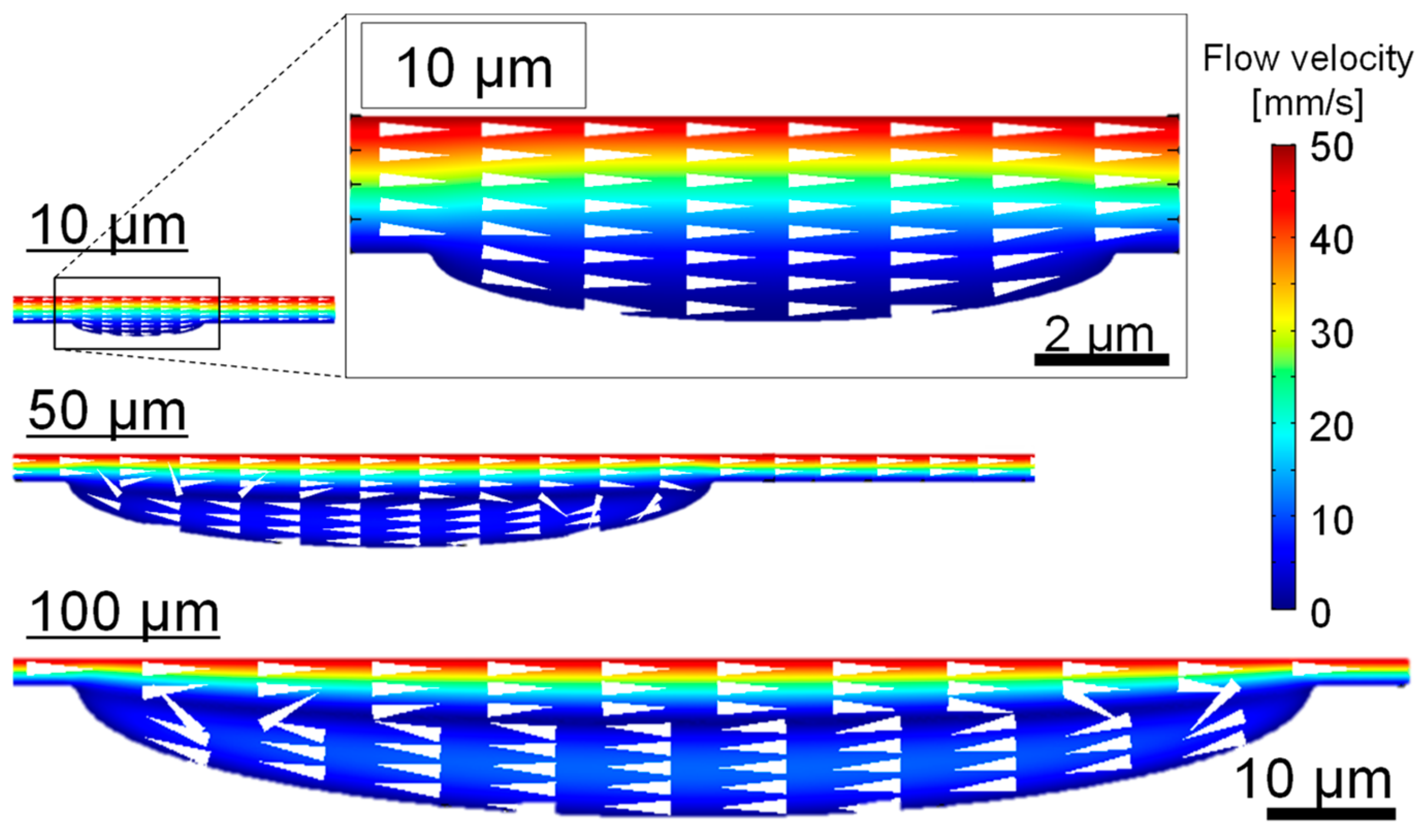
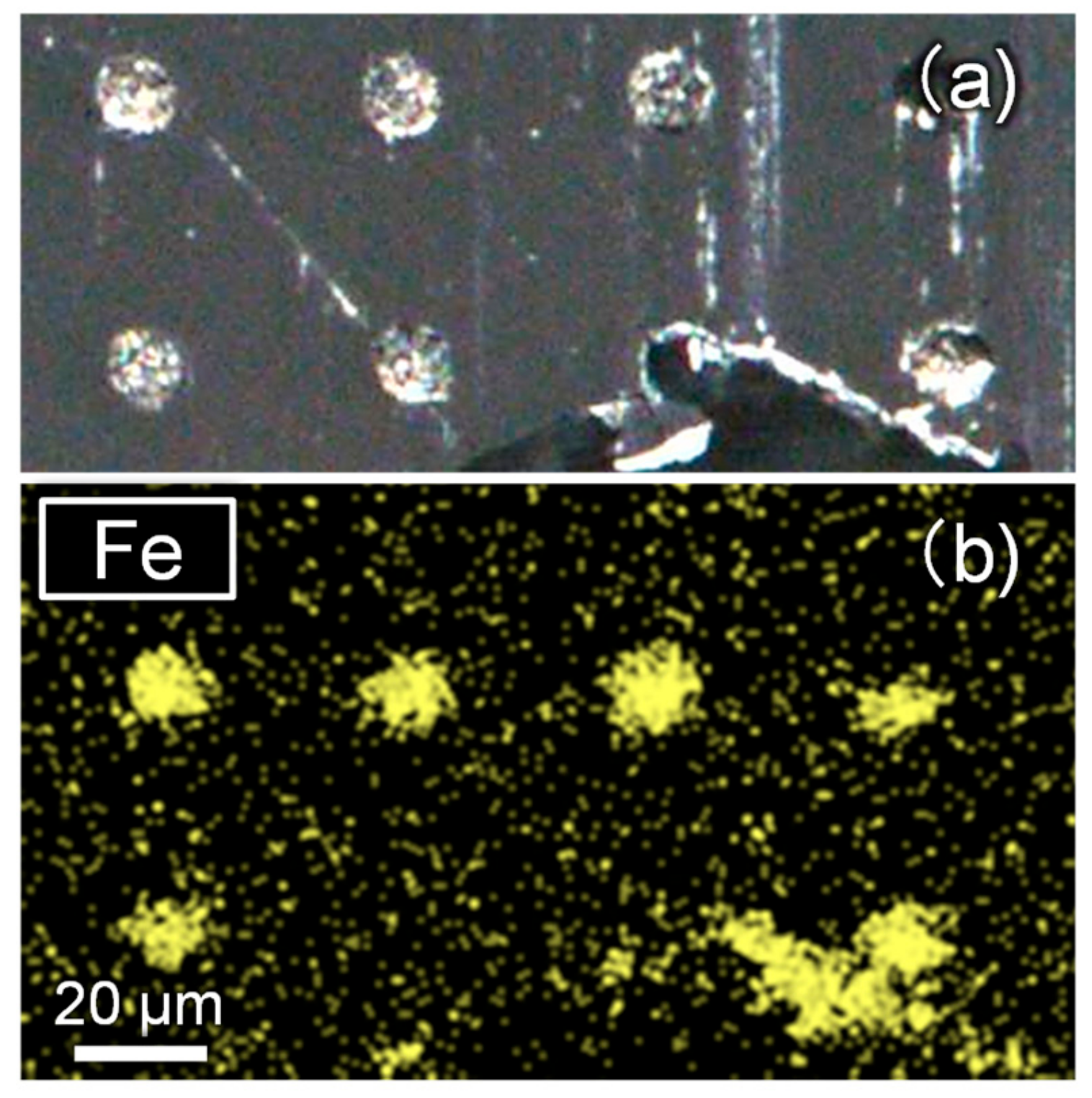
| Texture Density ρd | Aspect Ratio λ | Diameter d [mm] | Depth hd [mm] | Pitch b [mm] |
|---|---|---|---|---|
| 0.1 | 0.1 | 0.1 | 0.01 | 0.18 |
| 0.1 | 0.1 | 0.05 | 0.005 | 0.09 |
| 0.1 | 0.1 | 0.01 | 0.001 | 0.02 |
| Work Material | Stainless Steel | (JIS:SUS304-H) |
|---|---|---|
| Sheet thickness t | [mm] | 0.1 |
| Bending die radius rd | [mm] | 0.5 |
| Punch corner radius rp | [mm] | 0.5 |
| Clearance c | [mm] | 0.09 |
| Maximum stroke hs | [mm] | 4 |
| Punch Velocity vp | [mm/s] | 50 |
| Lubricant viscosity η | [mm2/s] | 1.27, 2.53, 4.51 |
| Material | Stainless Steel | Silica Glass Die | Tool Steel Die | (JIS:SUS304-H) |
|---|---|---|---|---|
| Material model | Elasto-plastic body | Elastic body | Elastic body | |
| Mass density ρ | [g/cm3] | 7.93 | 2.2 | 7.72 |
| Elastic modulus E | [GPa] | 200 | 72 | 206 |
| Yield stress σy | [MPa] | 1170 | - | - |
| Poisson’s ratio ν | 0.3 | 0.17 | 0.3 |
| Mass Density of Lubricant ρliquid | [kg/m3] | 899.8 |
| Lubricant viscosity of ηlub | [Pa·s] | 0.04 |
| Sliding speed vw | [mm/s] | 50 |
| Flow velocity vf | [mm/s] | 50 |
| Lubricant film thickness hl | [µm] | 2 |
| Density of gas ρgas | [kg/m3] | 1.2 |
| Viscosity of gas ηgas | [Pa·s] | 1.8 × 10−5 |
| Atmosphere temperature T | [K] | 293.15 |
| Contact angle θ | [degrees] | 20 |
| Mass Density ρ | [kg/m3] | 899.8 |
| Viscosity ηl | [Pa·s] | 0.04 |
| Sliding speed vw | [mm/s] | 50 |
| Lubricant film thickness hl | [µm] | 0.5, 1, 2 |
© 2019 by the authors. Licensee MDPI, Basel, Switzerland. This article is an open access article distributed under the terms and conditions of the Creative Commons Attribution (CC BY) license (http://creativecommons.org/licenses/by/4.0/).
Share and Cite
Shimizu, T.; Kobayashi, H.; Vorholt, J.; Yang, M. Lubrication Analysis of Micro-Dimple Textured Die Surface by Direct Observation of Contact Interface in Sheet Metal Forming. Metals 2019, 9, 917. https://doi.org/10.3390/met9090917
Shimizu T, Kobayashi H, Vorholt J, Yang M. Lubrication Analysis of Micro-Dimple Textured Die Surface by Direct Observation of Contact Interface in Sheet Metal Forming. Metals. 2019; 9(9):917. https://doi.org/10.3390/met9090917
Chicago/Turabian StyleShimizu, Tetsuhide, Hiroyuki Kobayashi, Jochen Vorholt, and Ming Yang. 2019. "Lubrication Analysis of Micro-Dimple Textured Die Surface by Direct Observation of Contact Interface in Sheet Metal Forming" Metals 9, no. 9: 917. https://doi.org/10.3390/met9090917





